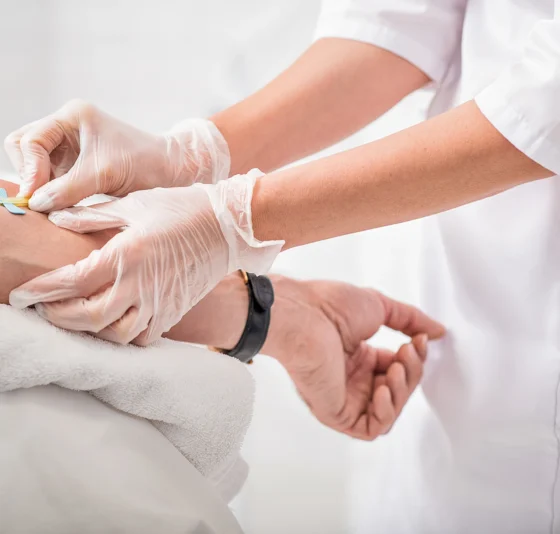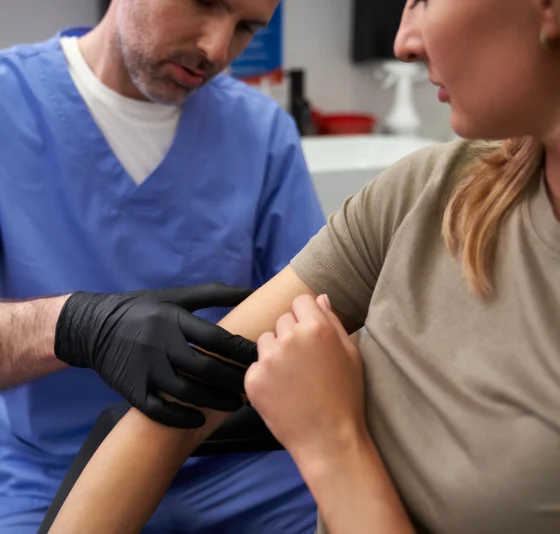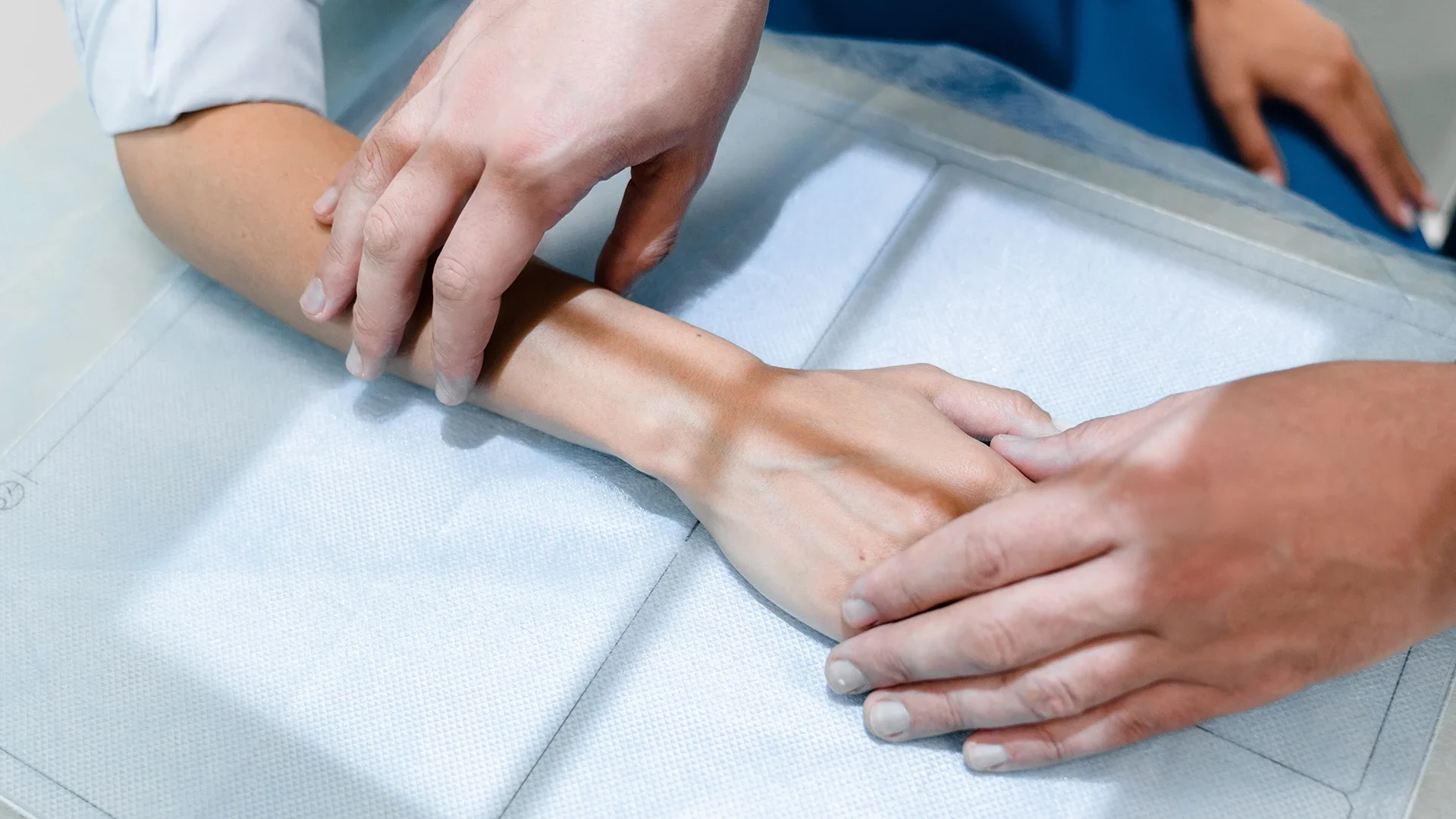For dialysis patients, a properly functioning access site is crucial for effective treatment. At the Orange County Interventional Radiology Center, we provide dialysis fistulograms and angioplasties — advanced procedures that help keep your dialysis fistula in optimal condition. Our expert interventional radiologists use the latest imaging technology to diagnose and treat blood clots, narrowing or other complications that could interfere with your dialysis treatment.
Book Appointment
Dialysis Fistulogram and Angioplasty

What Is Dialysis Fistulogram and Angioplasty?
A dialysis fistulogram is a diagnostic imaging procedure that uses contrast dye and X-ray technology to evaluate the blood flow in your access site, whether it’s an arteriovenous (AV) fistula or graft. This allows our interventional radiologists to identify and treat blockages that can cause high blood pressure during dialysis and interfere with the effectiveness of treatment.
Angioplasty is the minimally invasive treatment that often follows a fistulogram if a problem is discovered.
During this procedure, a tiny balloon is inserted into your access site and inflated to widen the vessel, restoring proper blood flow. Clot-dissolving medication may also be used. Occasionally, when angioplasty does not work, a stent may need to be placed.
Together, these procedures help maintain the longevity and function of your fistula, preventing complications and reducing the need for surgical revision. As outpatient procedures, they allow you to return home the same day with minimal disruption to your dialysis schedule.

Ideal Candidates for Dialysis Fistulogram and Angioplasty
Before recommending any procedure, our expert team carefully evaluates each patient’s dialysis access function, symptoms and treatment history. While these procedures benefit many dialysis patients, several factors help determine if this approach is right for you.
You may be a good candidate for dialysis fistulogram and angioplasty if you:
- Experience decreased blood flow or poor clearance during dialysis sessions
- Notice prolonged bleeding or increased swelling around your access site
- Feel unusual vibrations, pulsations or changes in the “thrill” of your fistula
- Develop high venous pressures during dialysis treatments
- Want to avoid more invasive surgical revision of your dialysis access
- Need prompt treatment to continue effective dialysis without interruption
As minimally invasive treatment options, dialysis fistulogram and angioplasty involve significantly less risk and downtime than surgery. If you’re experiencing issues with your fistula, our team can help determine if these procedures are right for you. We’ve helped countless patients maintain the functionality of their access site when complications arise.

What to Expect During Treatment
On the day of your procedure, you’ll arrive at our state-of-the-art facility in Lake Forest, Mission Viejo or Irvine. The process begins with a brief preparation period where our team will check your vitals and administer local anesthesia to ensure your comfort.
Next, our interventional radiologist inserts a small needle into your fistula. Contrast dye is injected, allowing us to view your access site under X-ray guidance and identify any problem areas. If narrowing or blockage is detected, angioplasty will be performed immediately. A specialized catheter with a balloon attachment is guided to the affected area and carefully inflated to widen the vessel. You may feel some pressure during inflation, but the procedure is generally not painful. If necessary, a stent may be placed to maintain the opening.
Throughout the entire process, which typically takes 60-90 minutes, you’ll remain awake but comfortable. Upon completion, the catheter is removed, and pressure is applied to prevent bleeding. No stitches are required, and only a small bandage covers the entry site.
Dialysis Fistulogram and Angioplasty Recovery

Dialysis fistulogram and angioplasty involve minimal downtime. Most patients can return home the same day after a brief observation period. You may experience some mild soreness or bruising at the access site, which typically resolves quickly with over-the-counter pain relievers.
It’s important to monitor your access site in the days following treatment and report any unusual changes to your healthcare provider. These might include excessive swelling, bleeding, increased pain, fever or a decrease in the “bruit” (sound) or “thrill” (vibration) of your fistula.
Book Appointment
Take the First Step Toward Relief
At the Orange County Interventional Radiology Center, we understand that your dialysis access site is your lifeline. If you’ve noticed concerning changes in your fistula, contact us at (949) 317-1633 to schedule a consultation and explore your treatment options. Our experienced interventional radiologists can help maintain your dialysis access site with the most advanced and minimally invasive care available.


Our Locations
Three Locations, One Commitment: Your Care
Lake Forest
29300 Portola Parkway, Suite B
Lake Forest, CA 92630
Toll Free: (800) 267-5677
Hours of Operation
Monday: 8:00 AM – 5:00 PM
Tuesday: 8:00 AM – 5:00 PM
Wednesday: 8:00 AM – 5:00 PM
Thursday: 8:00 AM – 5:00 PM
Friday: 8:00 AM – 5:00 PM
Saturday: Closed
Sunday: Closed
Mission Viejo
26921 Crown Valley Parkway, #120
Mission Viejo, CA 92691
Toll Free: (800) 267-5677
Hours of Operation
Monday: 8:00 AM – 5:00 PM
Tuesday: 8:00 AM – 5:00 PM
Wednesday: 8:00 AM – 5:00 PM
Thursday: 8:00 AM – 5:00 PM
Friday: 8:00 AM – 5:00 PM
Saturday: Closed
Sunday: Closed
Irvine
18102 Sky Park Circle South, Suite D
Irvine, CA 92614
Toll Free: (800) 267-5677
Hours of Operation
Monday: 8:00 AM – 5:00 PM
Tuesday: 8:00 AM – 5:00 PM
Wednesday: 8:00 AM – 5:00 PM
Thursday: 8:00 AM – 5:00 PM
Friday: 8:00 AM – 5:00 PM
Saturday: Closed
Sunday: Closed